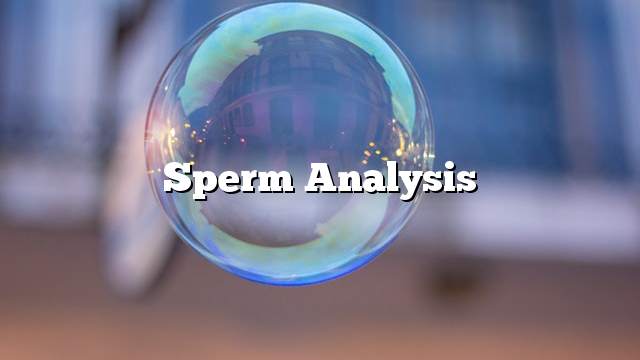Analysis of semen is referred to doctors to diagnose many diseases, especially when infertility through detection and analysis can identify the problem and work to solve:
How the sperm is detected
Wait 30 minutes after ejaculation until fluid leaks and measure the semen volume …
Natural size 2-6 mm
Viscosity: Immediately after ejaculation, the semen is in the form of a gel. This requires 30 minutes to be removed. Therefore, the sperm can move in. Therefore, if the semen is not removed within 30 minutes or thick, the sperm can not move. This usually occurs in the presence of prostate or seminal vesicles
PH: Usually the sperm is alkaline to protect the sperm from the acidity in the vagina and if the semen is acidic, this is the result of the absence of sperm or the result of blockage in the ejaculation channel
Fructose sugar: Fructose is secreted from spermatozoa and gives sperm energy to help it move. Lack of fructose is evidence of a blockage in the ejaculation channel
A number of basic tests of the fluid are revealed under the microscope. The sperm appears in the shape of the frog chick. It consists of the head bearing the nucleus and the father and tail chromosomes, which help the movement, including an intermediate part that supplies the sperm with energy
We usually check below the microscope:
1. Number of sperm
2. The movement of sperm
3. Shape of sperm
There are other tests
- Number of sperm: If the number of sperm is less than 20 million, the incidence of pregnancy is significantly reduced and less if the proportion of less than 10 million. The microscope is used to detect the number of spermatozoa, since the sperm is micro-sized (50 μm) and is visible to the naked eye and sometimes there is no sperm effect. Although sperm appears normal
• Movement: The ability of sperm to move is very important and more important than the number and there is a type of sperm is able to move and other type is not able to move and of course the animals are able to move is able to reach the tubes and be able to fertilize the egg divided sperm to 4 I (according to the World Organization)
1-a-a-fast forward … sperm moving fast in a straight line forward (such as guided shell)
2-B-B Slow forward … The sperm move forward but slowly or in a straight line
3-C-C non-advanced itching …. We see the tail moving but the sperm in position does not move
4-D-D is not moving …… sperm do not move permanently
The movement is abnormal and the sperm is unable to reach the egg
Sperm shape : Consists of the head that contains genes, any factors of inheritance and the middle section called the neck, which gives the energy needed for the sperm and sperm of the movement and the tail, which helps to push sperm within the female genital canal. We would like to point out here that men begin to produce sperm only at puberty, unlike women who produce and ovulate eggs.
